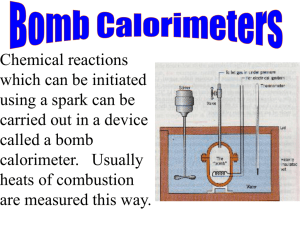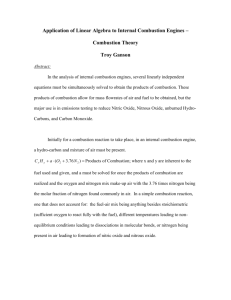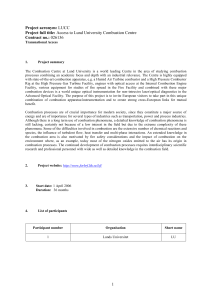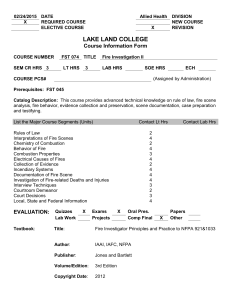Heat of Combustion of Oils
advertisement
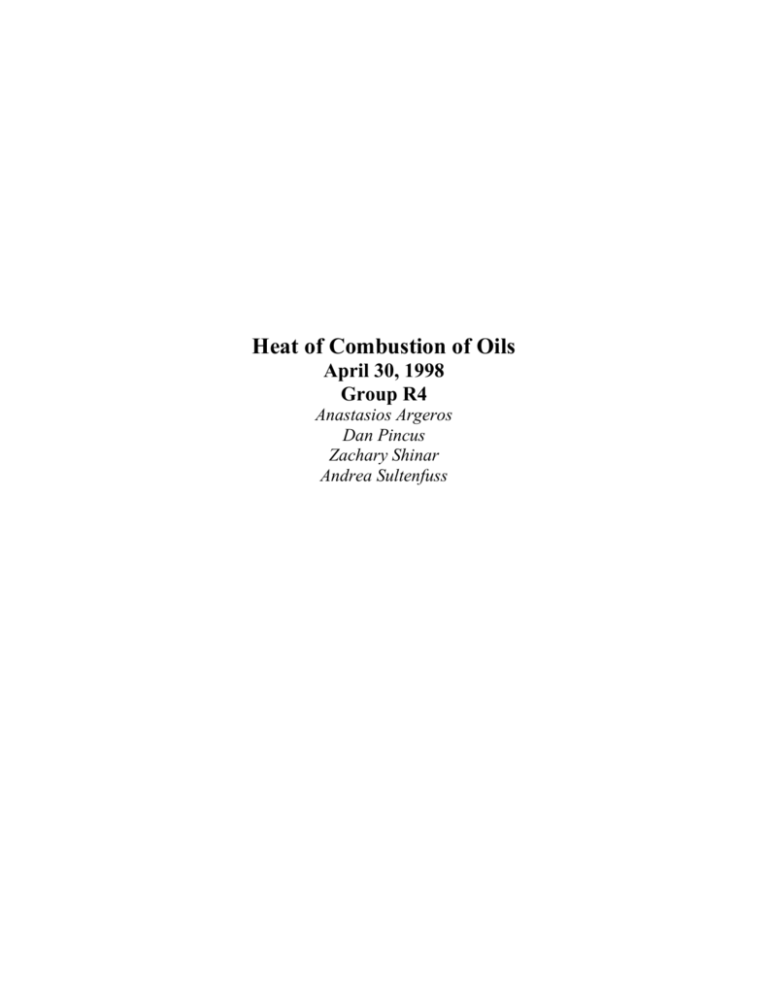
Heat of Combustion of Oils April 30, 1998 Group R4 Anastasios Argeros Dan Pincus Zachary Shinar Andrea Sultenfuss Abstract To determine a relationship between heat of combustion and degree of saturation, olive oil (regular and extra virgin), canola oil, and soybean oil were combusted using a non-adiabatic Parr bomb calorimeter. The heat of combustion was expected to increase with the degree of saturation. According to the level of saturation, olive oil was expected to have the greatest heat of combustion, followed by canola oil, and then soybean oil. The experimental data showed that the differences among heats of combustion of the oils were insignificant. The observed average heats of combustion of olive oil are 39.31+0.709 kJ/g (regular) and 40.98+0.145 kJ/g (extra virgin). The average heats of combustion for canola oil and soybean oil are 41.45+0.471 kJ/g and 40.81+0.325 kJ/g, respectively. Though the standard deviation for each set of trials is below 2% of the heat of combustion, the ranges of each set overlap one another. Nevertheless, the experimental data are within the standard deviation of other data obtained using similar equipment and procedure. The insignificance of the data can be explained by the small variance in the heats of combustion of the constituent fatty acids. Since the deviation of the heats of combustion of the fatty acids is only 0.6% while the deviation in the experimental results is 0.9%, no significant difference should be expected from our data. The differences in the heats of combustion of the oils due to saturation are too small to detect using the resources available. A final point of analysis concerns the nutritional labels used by the FDA. Our data was 13.2% lower than the caloric value on nutritional labels. This is most likely explained by the FDA’s cessation to use bomb calorimetry and instead approximation the caloric content of the food from the ingredients. 2 BE 210 Final Project Combustion of Oils Group R4 Table of Contents Background ......................................................................................4 Energy Dependence and Structure of Fats ...................................4 Bomb Calorimetry .......................................................................7 Human Metabolism ......................................................................7 Bomb Calorimetry and the Human Body ....................................8 Materials and Apparatus ..................................................................9 Procedure .......................................................................................10 Standardization with Benzoic Acid ...........................................10 Combustion of Oils ....................................................................10 Results ............................................................................................12 Discussion ......................................................................................14 InsignificanT Difference of Data ...............................................14 Experimental Results vs. Expected Results and FDA ...............17 References ......................................................................................20 Appendix A ....................................................................................21 Appendix B ....................................................................................24 3 BE 210 Final Project Combustion of Oils Group R4 Background Organisms obtain energy by breaking down proteins, polysaccharides and fats. Consider the cellular metabolism for the extraction of energy from fats, a potent source of energy as a result of their complex, multi-bond hydrocarbon structure. Through aerobic respiration, the human body will break down these hydrocarbons and render the carbon and hydrogen in their most stable, lowest energy forms, CO2 and H2O, and produce ATP and NADH in the process. (1) Thermodynamically, this process releases energy that is utilized by the organism. The process of releasing the bond energy in fats may be replicated in a bomb calorimeter, which permits the measurement of the amount of energy present. Energy Dependence on Structure of Fats A fat is a glycerol molecule bonded to a combination of fatty acids or hydrocarbon chains. Usually, the glycerol bonds to three fatty acids, forming a triglyceride (Figure 1). A fat that has no double bonds between the carbon atoms in the fatty acid Hydrogen Oxygen Carbon Figure 1: Saturated Lipid 4 BE 210 Final Project Combustion of Oils Group R4 chain is deemed “saturated” with hydrogen atoms (Figure 2). The degree of saturation of the fatty acid governs the quantity of energy contained within. The presence of double bonds in unsaturated fat lowers the energy of the molecule, with respect to a saturated fat which has only single bonds. The reasoning is simple: the bond energy of a single bond is approximately 3.5 eV and that of a double bond is 6.4 eV. Therefore, the breakdown of two single bonds releases more energy than one double bond (7eV versus 6.4 eV) (10). This confirms that a saturated fat has more energy than an unsaturated. Figure 2: Illustration of structures of saturated and unsaturated fats. Unsaturated H H H CC C C H H H H H Saturated H H H H C CCCH H H H H Among unsaturated fats, varying degrees of saturation are possible which depends on the concentration of the each of the fatty acids. The most prevalent fatty acids found in vegetable oils are oleic and linoleic acid. Figure 3 illustrates two unsaturated fatty acids, as evidenced by the presence of at least one double bond. Figure 3: Structure of fatty acids common in oil (5) 5 BE 210 Final Project Combustion of Oils Group R4 A signature characteristic of an unsaturated fatty acid is the kink that each double bond induces on the otherwise straight chain (when saturated). Among the two fatty acids above, oleic acid has a higher degree of saturation, evidenced by its one double bond versus linoleic acid’s multiple double bonds. Among the three oils used experimentally olive oil is the most saturated with the greatest percentage of oleic acid, while canola oil is slightly less saturated and soybean oil is the least saturated with the Figure 4: Percent composition of fatty acids in three oils % Composition Oleic and Linoleic Acid in Oils 80 70 60 50 40 30 20 10 0 Oleic Linoleic Olive Canola Soybean Oil Type highest percentage of linoleic acid, as illustrated in Figure 4. Table 1 contains approximate values for the heat of combustion as given in the Food Composition and Nutrition Tables (7). As expected, olive oil has the greatest heat of combustion while the heat of combustion of soybean oil is the lowest value of the three oils. Table 1: Heats of combustion for three oils (7) Oil Type Heat of Combustion (kJ/gram) Olive Oil 38.76 Canola Oil 38.52 Soybean Oil 38.37 6 BE 210 Final Project Combustion of Oils Group R4 Bomb Calorimetry The total energy released by the combustion of a fat is the heat of combustion, and is measured by a technique called bomb calorimetry. The fat is consumed in a pressurized bomb, which transmits the generated heat to surrounding water. Based on the change in temperature of the water the heat of combustion can be computed using the following equation: Qreaction msample Hcomb mwater Cpwater Twater where msample is the mass of the oil, mwater mass of the water, Cpwater is the specific heat of water, and Twater is the change in temperature of the water. Errors are present in bomb calorimetry. One must account for the absorption of heat by the bomb, water, jacket and the bucket, and not just the water. Heat loss will occur since the bomb is non-adiabatic. Secondary reactions may also occur under the conditions in the bomb. The consumption of the fuse wire adds heat to the system. All of these errors are accounted for in a detailed discussion in Appendix A. Human Metabolism How are fats treated by the human digestive system? They are first enzymatically broken down into smaller units, fatty acids and glycerol. This is called digestion and occurs in the intestine or cellularly by lysosomes. Next, enzymes remove two carbons at a time from the carboxyl end of the chain, a process which produces on molecule of acetly CoA, NADH and FADH2. The acetyl CoA is a high energy molecule that is then treated by the Citric Acid Cycle which oxidizes it to CO2 and H2O and produces more 7 BE 210 Final Project Combustion of Oils Group R4 NADH and ATP. Finally, the electron transport chain takes the electrons that NADH and FADH2 gain when oxidizing other molecules and phosphorylates ADP to ATP.(1) Bomb Calorimetry and the Human Body Is bomb calorimetry an accurate method of measuring the amount of energy the body will obtain from a sample of oil? There are considerable distinctions between the body and bomb, but both employ the breaking of the bonds in the fatty acid’s hydrocarbon chain. Bomb calorimetry accounts for all the energy released in all the bonds, where as there are bonds that the body does not break, and therefore they do not contribute to the energy the body obtains. These components may be excreted, converted into lipid bylayers, and some may become adipose tissue.(1) 8 BE 210 Final Project Combustion of Oils Group R4 Materials and Apparatus Oils (soybean, olive, and canola) Benzoic acid 0.0709 N Na2CO3 Methyl red indicator 1341 Parr bomb calorimeter 1108 Parr oxygen bomb Thermometer and magnified viewing lens Ignition unit Mettler PB303 balance Parr bomb calorimeter and ignition unit 1 Parr bomb calorimeter and ignition unit (4) Mettler BD6000 balance 9 BE 210 Final Project Combustion of Oils Group R4 Procedure Standardization with Benzoic Acid In order to determine the energy equivalent factor of the calorimeter, benzoic acid was combusted first. Approximately 0.6 grams of solid benzoic acid was compacted into a pellet and placed in a clean cup in the bomb. A 10 cm fuse wire was set in place so that it rested just above the pellet. The bomb was pressurized to 25 atm with pure oxygen gas. The bomb was then placed in 2003 grams of water in the calorimeter. Following the the procedure outlined in the Parr Bomb Manual the apparatus was allowed to equilibirate for 5 minutes. The temperature was then taken every minute for a second 5 minute period. At the end of this period the bomb was ignited and the temperature was taken every 15 seconds for the next 4 minutes. The temperature was then taken every minute for approximately 10 more minutes. The final length of the fuse wire was measured to calculate the heat released from the consumed wire. The contents of the bomb were titrated to determine the amount of nitric acid formed in the combustion. The energy equivalent factor was computed using the Equation 1 and the corrections in Appendix A. Combustion of Oils Once W was determined, olive oil, soybean oil, and canola oil were combusted in the calorimeter using approximately 0.43 grams of oil. A slightly different procedure was used to combust fluids rather than solids. The oil was massed in the metal cup used in the bomb. The cup was then placed in the bomb at an angle to gather the oil in one side of the cup to decrease the possibility of 10 BE 210 Final Project Combustion of Oils Group R4 incomplete combustion of the oil (Figures 6, 7). As in the combustion of the benzoic acid, the fuse wire was placed just above the oil. Oils Tilted Basket Figure 6: Standard cup placement Figure 7: Improved cup placement The combustion then proceded following the methods for the trials of benzoic acid. Three trials were conducted for each oil and the results tabulated with Excel. (8) Using the energy equivalent factor, the heats of combustion were calculated using Equation 5 from Appendix A. 11 BE 210 Final Project Combustion of Oils Group R4 Results The heat of combustion of benzoic acid from three trials is 3043+56.8 kJ/g with an energy equivalent factor of 10.87 kJ/C. This W value was then used to calculate the average heats of combustion for each of the oils tested. Table 2 shows these heats of combustion and standard deviations for each of the oils tested. The standard deviations are minimal relative to the heat of combustion, each under 2% of their respective Hc. However, the average heat of combustion of the oils varies by only 2.3% which causes overlap among the individual averages as well as insignificance of the difference in the means of the oils. The t-test values (Appendix B) provides further evidence for the Table 2: Average heats of combustion of each oil tested. Avg Hc (kJ/g) St. Dev (kJ/g) % St. Dev Soy Oil 40.81 0.325 0.80 Canola Oil 41.45 0.471 1.1 Olive Oil 39.31 0.709 1.8 Extra Virgin Olive Oil 40.98 0.145 0.35 Average of all oils 40.63 0.940 2.3 insignificance differences between the data. Figure 8 displays the normalized average temperature rise of each oil showing the small deviations in each of the trials. The same mass of water and approximately the same mass of oil was used in each trial. The graph shows that the average temperature rise for the oils was 1.658+0.059 C. The precision of the heats of combustion is shown by the low standard deviation of 2.3%. The heats of combustion do not correspond to the expected values displayed in Table 1. Table 3 juxtaposes the experimental data with the expected results. The experimental results vary from the expected results by an average of 5.3%. The 12 BE 210 Final Project Combustion of Oils Group R4 experimental values are also 13.2% off the values provided in the nutritional information from the manufacturer (120 kcal in a 14 gram serving). As a check for further precision, the experimental results were compared with the results of two similar experiments in which the heat of combustion of fat was found to be 39.56 kJ/g (3) and 38.92 kJ/g (9). These values are within 2.7- 4.2% of the experimental average of 40.63+0.940 kJ/g. Figure 8: Temperature rise for one trial of each oil. Table 3: Comparison of experimental and expected results. Avg Hc (kJ/g) Expected (kJ/g) % difference Soy Oil 40.81 38.37 6.4 Canola Oil 41.45 38.52 7.6 Olive Oil 39.31 38.76 1.3 Extra Virgin Olive Oil 40.98 38.76 5.7 13 BE 210 Final Project Combustion of Oils Group R4 Discussion Insignificant Differences in Data The insignificant differences of the data conflict with the predictions that there exists a direct relationship between degree of saturation and heat of combustion. Explication of the experiment and results will demystify the difference beteween predicted results and expected. First, a comparison between our data and that of two independent experiments was necessary in order to confirm that our data was reasonable. First, a group at Pennsylvania State University used bomb calorimetry to combust fats and obtained a value of 39.56 kJ/g.(3) The error in their experiment was not stated, but any error greater than 0.13% places their value within our data’s standard deviation (40.63+1.02 kJ/g). The second set of experimental data was from a study done by Atwater. Using a bomb calorimeter the researchers found the heat of combustion of fat to be 9.3 kcal/g or 38.93 kJ/g, slightly lower than the Penn State experiment and 1.75% below our standard deviation.(9) Considering the impure composition of such oils, these deviations are reasonable, and from these two values, our data seems to fit the experimental norm for the heats of combustion of fats. Table 4: Comparison of our experimental results with two other groups using bomb calorimetry. The standard deviation of our experimental average is factored into the heat of combustion presented. Hc (kJ/g) % difference Experimetal Results 39.61 -- Penn State Group 39.56 0.13 Atwater 38.93 1.75 On the premise that our mean heat of combustion, one must question why the data is insignificant. The answer lies a detailed analysis of the compositions of oils is 14 BE 210 Final Project Combustion of Oils Group R4 necessary. Oils consist of approximately 95% fatty acids and 5% glycerol and additives by mass. The glycerol content is the same for every triglyceride, since there is one glycerol molecule bonded to three fatty acids. The amount of glycerol would not vary significantly because the oils contain the same amount of triglyceride. Moreover, the variation in the other additives causes even less of a deviation in the heat of combustion of the oils since the concentration of these components varies by less than 10 g per gram of oil. These substances would not affect the total heat of combustion because of their minute size and small variance. The glycerol and additives contribute to a systematic error inherent in every trial conducted which sets the total heat of combustion apart from the heats of combustion of the individual fatty acids. While each oil contains similar amounts of glycerol and additives, the concentration of each of the fatty acids determines the degree of saturation of the oil. Therefore, an examination of the heats of combustion of each individual fatty acid will show the degree to which the heats of combustion of the entire oil may differ. Table 5 compares the individual heats of combustion of the most prominent fatty acids in the oils. These fatty acids reflect the opposite ends of the saturation spectrum. Stearic and palmitic acids are saturated whereas oleic acid is monounsaturated and linoleic acid is polyunsaturated. While these values for the heats of combustion do represent the expected trend of a higher heat of combustion corresponding to the more saturated fat, the greatest difference between the heats of combustion of all five of the major constituents of oils is 0.61 kJ/g. Even these high differences in the degree of saturation reflect only marginal differences in the heat of combustion. In fact, the standard deviation for these oils, 0.61%, is smaller than the average standard deviation for our 15 BE 210 Final Project Combustion of Oils Group R4 data, 0.95%. Varying the concentration of each of the primary fatty acids in an oil would have little effect on the total heat of combustion of the oil. In order to detect any significant difference in the heats of combustion of the oils, the standard deviation of the experiment must be greater than that of the heats of combustion of the fatty acids. Therefore, a difference in the heat of combustion for various degrees of saturation should not be expected, because the expected difference is smaller than our expected error. Table 5: Accepted heats of combustion for the major fatty acids of the oils tested. (6) Hc (kJ/g) Oleic Acid 39.39 Palmitic Acid 39.11 Stearic Acid 39.62 Linoleic Acid 39.30 Linolenic Acid 39.01 Average 39.29 St. Dev. 0.61% Exp. St. Dev 0.95% The precision of the bomb calorimeter accounts for the insignificance of the experimental heats of combustion of the oils. The Parr Bomb is not precise enough to measure the minute differences that saturation plays on the heat of combustion. The precision of the bomb calorimeter used was found to be 0.83% from the combustion of pure benzoic acid. Our deviation of 0.95% is greater than this precision due to the impurity of the oils combusted. However, the precision of the bomb calorimeter is less than the variation of the fatty acids. Therefore, the bomb calorimeter used is unable to detect the differences in the heats of combustion of the oils resulting from a change in the concentration of the fatty acids. 16 BE 210 Final Project Combustion of Oils Group R4 After all the corrections for temperature, nitric oxide formation, and fuse wire consumption, there is still human error that cannot be completely eliminated. The human error consists of measuring the fuse wire (+0.05 cm), placing the correct amount of water in the calorimeter, avoiding water loss during setup of the trial, and correctly measuring the temperature rise. There is also +0.001 g error in the measurement of the oil mass, a +1 g error in the massing of the calorimeter water, and +0.005 C error in the thermometer. Coupled with these are dynamic errors. Slightly different initial water temperatures cause a different amount of heat to escape from the calorimeter than during the benzene correction. Another potential source of error was the chance that the entire amount of oil was not consumed during combustion. The oil could have spilled during loading or been confined away from the rest of the sample. Using approximations for the dynamic and human error, these errors amount to approximately 0.2%. Though they are small, they are important when dealing with such a small source of error (around 0.95%). Therefore, a reduction in this error would make the small differences in the heat of combustion caused by the degree of saturation more visible. This would enable a better picture of exactly what role saturation plays on oils, however it still leaves the error out of the range of the deviation of the heat of combustion of the fatty acids. Experimental results vs. expected results and FDA information The second point of discussion addresses the discrepancies among the experimental results, the expected results, and the nutritional information provided by the manufacturer. This experiment combusted the various oils using a static bomb calorimeter which quickly breaks down the oil into smaller molecules of water and 17 BE 210 Final Project Combustion of Oils Group R4 carbon dioxide. The heat of combustion is then calculated using the temperature change of the water surrounding the bomb. However, the Food and Drug Administration or other groups have not carried out such a test in many years. Instead, the heat of combustion may be calculated rather than tested in a bomb. Secondly, there is much variation among brands of oil and the preparation processes, affecting the heat of combustion of the product. This explains the difference between the expected and experimental results. The nutritional information provided on the food label of the oil also differs greatly from the data. In researching the caloric and fat contents of different oils, it was found that independent of the oil type, a serving contained the 120 kcal and 14 g of fat. Only the amounts of each type of fat, monounsaturated or polyunsaturated, varied. The number of kilocalories in each serving equates to 35.88 kJ/g of oil, significantly lower than experimental values because the manufacturer and the FDA consider only the digestible portion of each serving. Sources on food composition consider that about 95% of total calories available are digestible. The remaining 5% are never digested and are excreted. However, this leaves more than 7% of the discrepancy unaccounted. This could also be explained by the food composition testing actually done by the FDA. As aforementioned, these tests are rarely carried out today and instead accepted values for the heat of combustion of foods in the body are used. Furthermore, the bomb and the body combust materials in different ways. The bomb quickly breaks the entire mass of oil into smaller components of CO2 and H2O. The side reactions that may occur in the bomb are accounted for in the calculation of the heats of combustion. However, as the body digests a fat, the fat is broken into smaller and smaller carbon chains. The body will use some of the energy while the rest of the 18 BE 210 Final Project Combustion of Oils Group R4 fatty acid and glycerol of the oil are stored as a triglyceride in the body. Some energy is expended in the storage of the fat as a triglyceride; approximately 3 kJ/gram of fatty acid stored. Eventually, this stored fat will be combusted as the human body taps into its energy reserves or is broken down after death. This accounts for another 7% of the total heat of combustion which manufacturers or the FDA might not consider. This is a possible explanation for the 12% discrepancy between the experimental heat of combustion and the value provided on the nutritional information labels. To detect small differences in the heats of combustion of oils of varying saturation a more precise bomb calorimeter is necessary. To obtain average heats of combustion which are significantly different from one another, the standard deviation of all the trials must be lower than the deviation we encountered. However, using the apparatus provided for the experiment, a significant difference between the heats of combustion of the oils was unattainable. 19 BE 210 Final Project Combustion of Oils Group R4 References 1. Alberts, Bray et al. Essential Cell Biology. Garland Publishing: New York, 1998. 2. BE210 Lab Manual, Spring 1998. 3. http://nutrition.hhdev.psu.edu/ 4. http://parrinst.com/1341_plain_calorimeter.html 5. http://tnason.home.mindspring.com/oils.htm 6. http://webbook.nist.gov/ 7. Munchen, Garching, ed. Food Composition and Nutrition Tables, 1989/90. Wissenschaftliche Verlagsgesellschaft mbH: Germany, 1989. 8. Parr Bomb Manuals. 9. Paul, A.A, and Southgate, D.A.T. The Composition of Foods. Holland Biomedical Press: London, 1978. 10. Zumdahl, Steven. Chemical Principles. D. C. Heath and Co.: Lexington, 1995. 20 BE 210 Final Project Combustion of Oils Group R4 Appendix A Calculations for Heat of Combustion A relationship between the change in temperature of the water and the actual heat produced can be determined by combusting a compound, benzoic acid, of a precisely known heat of combustion. The energy equivalent factor, W, is determined using the following equation: W Hm e1 e 2 t Equation 1 where H is the accepted value for the heat of combustion of benzoic acid, m is the mass of benzoic acid combusted, e1 and e2 are correction factors for the formation of HNO3 and the combustion of the fuse wire, and t is the corrected change in temperature.(8) Secondary reactions, error in temperature readings and heat lost to the air necessitate consideration as well. Oils have traces of nitrogen, and so the formation of nitric acid may occur, an exothermic process. Therefore, the amount of HNO3 formed must be determined by titrating the contents of the bomb after the combustion is complete. One joule of energy is released per mL of 0.0709 N Na2CO3 used to titrate the solution. Equation 2 determines the quantity of heat released through the formation of nitric acid.(8) e1 mL _ Na 2CO3 1 Joule mL Equation 2 The consumption of the fuse wire is an exothermic reaction that adds to the temperature change of the water. Therefore, the amount of heat released must be calculated and subtracted from the heat of combustion of the oil. The manufacturer 21 BE 210 Final Project Combustion of Oils Group R4 supplies a value of 2.3 J/cm of wire consumed. The energy released by the combustion of the fuse wire, e1, is determined using Equation 3.(8) e 2 2.3 Joule cm _ fusewire cm Equation 3 Finally, it is also required that the transfer of heat between the calorimeter and the environment is determined. During the warm up and stabilization period, heat can be lost from the calorimeter to the surroundings. Equation 4 determines the corrected t tc ta r1b a r 2c b Equation 4 temperature t, where tc is the time at the beginning of the post period, ta is the temperature at the time of firing, r1 is the rate at which the temperature was rising during the preperiod, r2 is the rate at which the temperature was changing during the post period, a is the time of firing, b is the time at which the temperature rise is 60% of the full rise, and c is the time at the beginning of the post period. Both ta and tc are already corrected using the correction chart. The rates are necessary to correct for differences between the jacket and the surrounding environment during the preperiod, the rapid temperature rise, and the post period.(8) Incorporating each of the corrections, the final equation to determine the heat of combustion is shown in Equation 5. H Wt e1 e 2 m Equation 5 22 BE 210 Final Project Combustion of Oils Group R4 Where W is the energy equivalent factor, t is the corrected change in temperature, e1 is the heat of formation of the nitric acid and e2 is the heat of combustion of the fuse wire.(8) Figure 4 shows a typical graph of time versus temperature for the combustion of a substance. Figure 4: Example graph of temperature rise over time for the combustion of a substance. The periods and temperature points used in Equation 4 are noted. (8) 23 BE 210 Final Project Combustion of Oils Group R4 Appendix B Table 6: t-Test data for the four oils used t Stat Extra Virgin vs. Soy t Critical 0.1305 6.3137 -9.2354 6.3137 2.3332 6.3137 Soy vs. Olive -2.7938 2.9200 Soy vs. Canola -2.0781 2.9200 Olive vs. Canola -8.4997 2.9200 Extra Virgin vs. Olive Extra Virgin vs. Canola 24 BE 210 Final Project Combustion of Oils Group R4


